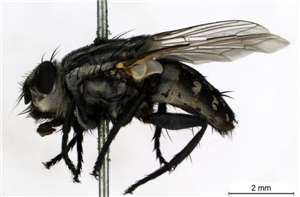Genus: Sarcophaga
Meigen 1826
Subgenus: Liopygia
Enderlein 1928
Species: crassipalpis Macquart
1839
Distribution
AFROTROPICAL, AUSTRALASIAN/OCEANIAN �
(Australia � Australian Capital Territory,
New South Wales, Queensland, South Australia, Victoria,
Western Australia), NEARCTIC, NEOTROPICAL, ORIENTAL, PALAEARCTIC.
Biology
Sarcophaga
crassipalpis has successfully been reared from
pork liver (Sanjean, 1957), and is known to complete
larval development in vertebrate and invertebrate
carcasses (P�rez-Moreno et al., 2006). This species is known to cause
myiasis in sheep and the spiny-tailed lizard Uromastyx
hardwicki, and oral, intestinal and cutaneous
myiasis and ophthalmomyiasis in humans (Shiota et al.,
1990; Shinonaga et al., 1999; Mart�nez-S�nchez et
al. 2006). Adults feed on faeces, carrion,
leaf-sucking hemipterans and from flowers (Castro et
al. 2010). This species has also been recorded by
JFW in forensic cases in Australia.
Taxonomy
The first- and second-instar larvae were described by Cantrell (1981) and the third-instar by Cantrell (1981) and Ishijima (1967). DNA barcode sequences of S. crassipalpis have been deposited in both GenBank and BOLD.References
Cantrell, B.K. (1981) The immature stages
of some Australian Sarcophaginae (Diptera:
Sarcophagidae). Journal of the Australian
Entomological Society 20, 237-248.
Castro,
C.B., Garcia, M.D., Arnaldos, M.I., and Gonz�lez-Mora,
D. (2010) Sarcophagidae (Diptera) attracted to piglet
carcasses including new records for Portuguese fauna.
Graellsia 66, 285-294.
Ishijima, H. (1967) Revision of the third stage larvae of synanthropic flies of Japan (Diptera: Anthomyiidae, Muscidae, Calliphoridae and Sarcophagidae). Japanese Journal of Sanitary Zoology 18, 47-200.
Macquart, J. (1839) 'Dipt�res.'In 'Histoire naturelle des Iles Canaries'. Tome Deuxi�me. Deuxi�me partie. Contenant la Zoologie [Entomologie]. (Eds. Webb, P.B. and Berthelot, S.)pp. 99-119. (B�thune, Paris).
Mart�nez-S�nchez, A., Maga�a, C.,
P�rez-Ba��n, C., Rojo, S., and Gonz�lez-Mora, D.
Taxonomy and larval study of flesh flies
(Diptera: Sarcophagidae) associated with human
corpses in Spain. In 'Proceedings of the Fourth
Meeting of European Association for Forensic
Entomology', 2006, Bari.
P�rez-Moreno, S., Marcos-Garc�a, M.A., and Rojo, S. (2006) Comparative morphology of early stages of two Mediterranean Sarcophaga Meigen, 1826 (Diptera; Sarcophagidae) and a review of the feeding habits of Palaearctic species. Micron 37(2), 169-179.
Sanjean, J. (1957) Taxonomic studies
of Sarcophaga larvae of New
York with notes on the adults. Cornell
University Agricultural Experiment
Station Memoir 349,
1-115.
Shinonaga,
S., and Kurahashi, H. (1969) New species
of Sarcosolomonia Baranov from New
Guinea and the Solomons (Diptera:
Sarcophagidae). Pacific Insects 11,
215-217.
Shiota, T.,
Yoshida, Y., Hirai, S., and Torii, S.
(1990) Intestinal myiasis caused by Parasarcophaga
crassipalpis (Dipera:
Sarcophagidae). Pediatrics 85,
215-217.





